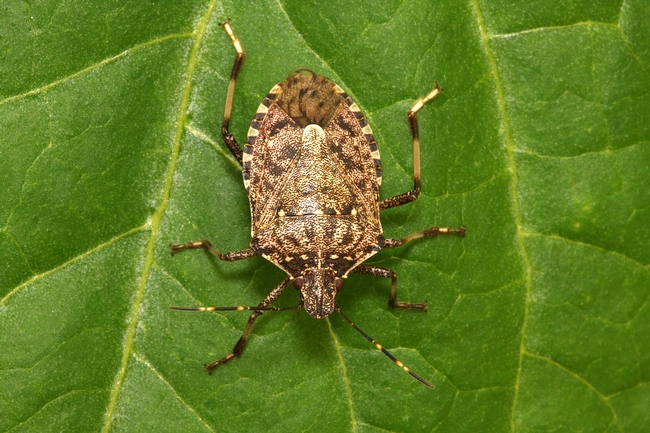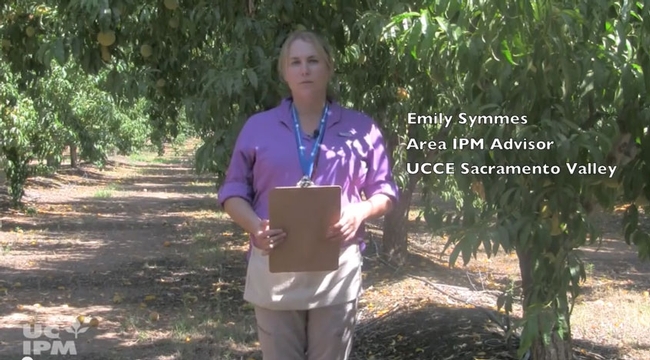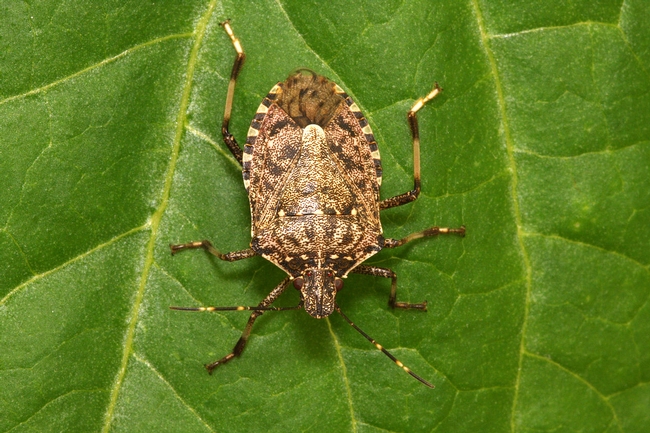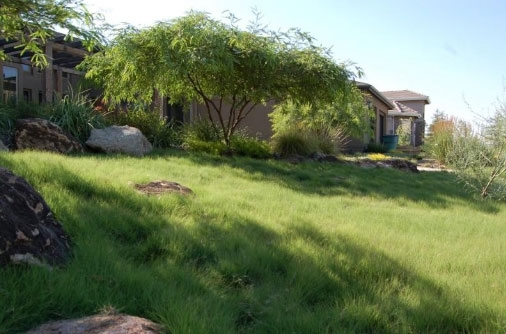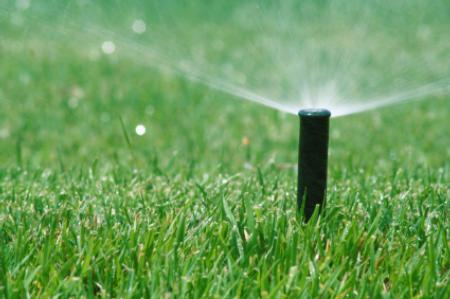Posts Tagged: Chuck Ingels
Brown marmorated stink bugs expected to have a 'banner year'
The California population of brown marmorated stink bugs, a pest introduced into the state from its native Asia, continues to spread and increase in and around Sacramento, said a UC Agriculture and Natural Resources (UC ANR) expert who appeared today on Capitol Public Radio's Insight program with Beth Ruyak.
Chuck Ingels, UC ANR Cooperative Extension advisor in Sacramento County, said BMSB was first spotted in 2013 in Sacramento and each year the numbers have grown. This year, the warm spring gave BMSB a head start, portending significant population growth in August and September 2015.
"We're very concerned about tree crops, tomatoes, peppers, corn, beans and other crops," Ingels said. On a bright note, he said California farms do not have forests surrounding them like farmers back East, where growers have been dealing with BMSB since the the mid-1990s. "BMSB is an arboreal species. They live in trees and then come into the farm. We're not sure how much of a problem it will be on farms here (in California)."
Ruyak asked whether any control solutions can be found in the pest's native territory or from farmers back East.
"Growers are using pesticides back East," Ingels said. "There is a parasitoid from China that is under study in labs to see if they pose a problem for native stink bugs and other bugs."
One possible solution for dealing with the pests in gardens is planting sunflowers. Because BMSB are strongly attracted to sunflowers, they may draw the pests away from other crops and allow gardeners to monitor the BMSB presence. On the other hand, sunflowers may actually attract BMSB to the garden, where they could feed on vegetable crops.
BMSB feeds with a mouthpart called a "proboscis," stinging developing fruit 1/4 to 3/8 inch deep and sucking out its juices. As the fruit ripens, it hardens and deforms, becoming inedible.
Read more about BMSB, how to identify it, and methods to manage it around homes and gardens in the UC IPM Pest Note: Brown Marmorated Stink Bug.
New videos from UC IPM help stone fruit growers and PCAs tackle pest problems
Spider mites, fruit moth and twig borer larvae, aphids, and bark cankers are just a few pests that can wreak havoc on stone fruit trees. With spring well underway and trees in full bloom and beginning to develop fruit, it's time to monitor and take action before these pests get out of hand.
The UC Agriculture and Natural Resources Statewide Integrated Pest Management (IPM) program teamed up with UC ANR farm advisors to develop a series of how-to videos that can help growers and pest control advisers monitor for pests and damage and determine if and when treatment is needed.
In one video, Sacramento Area IPM advisor Emily Symmes gives a brief overview of how to monitor for webspinning spider mites. Spider mites build up in stone fruit trees as the weather warms up. Late spring through summer is the ideal time to monitor for mites and their damage, which includes leaf stippling and webbing. If mites build up too much, leaves can drop, fruit may not fully develop, and branches and fruit can be exposed to sunburn.
Shoot strikes, or dead drooping leaf tips, are often seen on young peach and nectarine trees. In a second video, UC ANR farm advisor Janine Hasey explains how to monitor for shoot strikes and how to distinguish the culprits, Oriental fruit moth and peach twig borer. Although Oriental fruit moth and peach twig borer can bore into both foliage and fruit, they cause the most devastating damage by feeding on fruit. Early season monitoring and treatment can prevent future fruit loss.
In plum and prune orchards, leaf curl aphids and mealy plum aphids cause leaves to curl and become distorted. Aphids produce honeydew, which can lead to the development of sooty mold, causing fruit to crack and blacken. Aphids are often present when leaves start to grow. In his video, Rick Buchner, UC ANR farm advisor for Tehama County, discusses how to monitor for aphids and explains how to decide when treatment is warranted.
In a final video, UC ANR farm advisor Chuck Ingels teaches how to distinguish Phytophthora root and crown rot from bacterial canker. The two diseases are often confused because they both cause bark cankers. Phytophthora root and crown rot is confined to the lower trunk, but when a bacterial canker infection occurs in the tree trunk, the diseases can often be confused. Bacterial canker can be confirmed by cutting away the outer bark and looking for characteristic red flecks on the inner bark. Correct identification of these diseases will help in choosing a management strategy.
You can find all of these how-to videos on the UC IPM video library page. For specific information about managing pests in stone fruits or other crops, see the Pest Management Guidelines.
Nightmare in midtown: Brown marmorated stink bugs
A population of invasive brown marmorated stink bugs have settled in Sacramento's mid-town, a development that Sacramento Bee writer Debbie Arrington says is "worthy of a Halloween creature feature."
"Wow, I'm being overwhelmed with calls about brown marmorated stink bugs getting into people's home, as well as restaurants and businesses," said Chuck Ingels, UC Cooperative Extension advisor in Sacramento County. "It's that time of year again!"
When days get shorter and cooler, the BMSB start looking for a place to spend the winter. Frequently, that's inside homes and buildings.
Ingels told the reporter he is keeping track of the BMSB invasion. Residents are asked to fill in an online survey to report BMSB finds. For identification help, residents may deliver BMSB in a sealed plastic bag or container to the UCCE office, 4145 Branch Center Road, Sacramento, or they can email clear photos to cesacramento@ucanr.edu.
Ingels said fairly large populations of BMSB have been found in Citrus Heights near Auburn Boulevard and River Park north and west of CSU Sacramento.
"Most of the others are single finds," he said.
For more information on BMSB identification and management, read a Pest Note posted by the UC Integrated Pest Management program.
Green going out of fashion in California
Many Californians are beginning to reluctantly accept that a well-manicured, lush green lawn is no longer a realistic landscape feature in the arid West, reported Steven Kurutz in the New York Times.
Chuck Ingels, UC Cooperative Extension advisor in Sacramento County, told the reporter homeowners with traditional green lawns may soon have no choice but to let them go brown. An average of 50 to 60 percent of a household's water consumption goes to outdoor use, which includes the landscape. He envisions a future in which lawns go dormant in winter and in summer, if watering is not allowed.
“The water bills are going up,” Ingels said. “I think we're going to start seeing more and more people opt for a brown lawn. I think it could become more traditional.”
If some water is available, there are less thirsty alternatives to traditional lawns that can provide a similar effect. Ingels has experimented with meadow-like buffalograss and dune sedge as alternatives. For example, UC Verde buffalograss, released in 2003, was bred for the California climate by UC researchers. It needs only infrequent mowing, uses half the water of tall fescue and is disease and pest resistant.
Other options are drought-tolerant native species like carex and bentgrass. These can be used for the meadow effect if not mowed, or mowed regularly for a more traditional look.
Wait awhile before watering the lawn
Because of recent rainfall, California lawns have enough moisture in their rootzones to meet their water needs for the next several weeks, reported Matt Weiser in the Sacramento Bee. At a press conference yesterday, Chuck Ingels, UC Cooperative Extension advisor in Sacramento County, encouraged residents to find their automatic sprinkler controllers and turn them off.
“A single lawn sprinkler can use as much water as taking a shower,” Ingels said. “Many people don't even know where their (sprinkler) controller is. They are often hidden behind boxes or bicycles in the garage.”
The press conference was held jointly by the California Department of Water Resources, UC Cooperative Extension and UC Davis. The speakers noted that every drop of water saved by not watering already moist lawns will ensure there's more water when warmer months arrive. As part of the event, Ingels demonstrated a simple test to determine lawn moisture.
He easily pushed a flat-head screwdriver into the lawn up to its handle, indicating the soil beneath the surface is moist. If it doesn't sink in all the way or needs pressure, the lawn may need water.
In the coming months, there are many more strategies that can be employed to make the most efficient use of water placed on landscapes, which represents more than half of home water use.
Strategies include:
- Determine your home sprinklers' output by conducting a catch can test
- Program the controller to deliver water in short increments broken up with time for the water to soak into the ground
- Use drip irrigation for plants and trees
- Cover the soil with mulch to reduce evaporation from the soil surface
Read more here: Conserve water with proven landscape irrigation strategies
Additional home and ag water conservation resources are available from the UC California Institute for Water Resources, http://ucanr.edu/drought.


